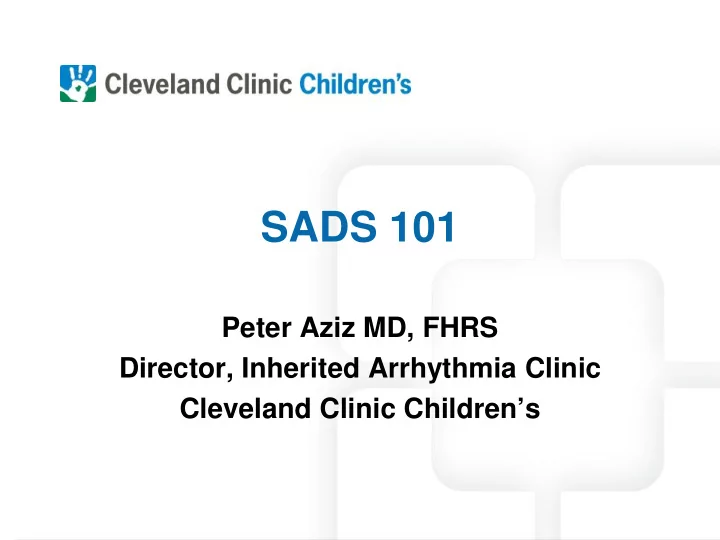

SADS 101 Peter Aziz MD, FHRS Director, Inherited Arrhythmia Clinic Cleveland Clinic Children’s
No Disclosures
The Channelopathy Timeline • 1889 – 1 st recorded channelopathic death - J-LN • 1960s – Romano and Ward describe LQTS • 1986 – 1 st BrS patient identified • 1991 – Keating identifies LQTS genetic location • 2000 – SQTS identified • 1995-present – Genetic data translated to bedside
The Conduction System
The Ion Orchestra
Case Presentation 21yo soccer player with syncope QTc = 540ms
Long QT Syndrome • Leading cause of autopsy-negative sudden death - 1000/year in the US - Mostly young children • Hallmark presentation: - Syncope – NO prodrome • Hallmark arrhythmia:
Long QT Syndrome
Defective Ion Channels Causes QT Prolongation +40mV K+ K+ -80mV T Q Q T
Epidemiology of LQTS • Equally present in all races and ethnic groups •
Estimated Prevalence of LQTS • Prevalence among white patients - 17/43,080 = 1:2534 • Most common and most studied ion channelopathy - Natural history - Treatment - Genotype:phenotype correlation - Risk stratification Schwartz, Circulation 2009
Long QT Classification • 16 genotypes have been identified • Three are the most common forms: - LQT1 - LQT2 75% of LQTS - LQT3 • Remaining genotypes account for 5% • 20% remain genetically elusive
Cornerstones of Therapy Trigger Modification Schwartz, JACC 2013
Trigger Avoidance • LQT1
Trigger Avoidance • LQT2
Trigger Avoidance • LQT3
Cornerstone of Therapy
Case Presentation #2 • 14yo with multiple syncopal events - First occurred at age 6 while chasing the ice cream truck • Exercise Stress Test
Cathecholaminergic Polymorphic Ventricular Tachycardia (CPVT) • SCD in the setting of emotional or physical stress - Smells like long QT, but the ECG is normal • Exercise stress test is the key - Frequent extra ventricular beats (PVCs) • 30% will have at least 1 cardiac arrest • 80% will have at least 1 syncopal event • Estimated prevalence - 1:10000
Cathecholaminergic Polymorphic Ventricular Tachycardia (CPVT)
Cathecholaminergic Polymorphic Ventricular Tachycardia (CPVT) Gene Protein Proportion of Inheritance CPVT (%) Pattern RYR2 Ryanodine 50-55 AD CASQ2 Calsequestrin 2-5 AR CALM1 Calmodulin <1 AD TRDN Triadin Unknown AR
Cathecholaminergic Polymorphic Ventricular Tachycardia (CPVT) Treatment ± Flecainide ±
Case #4 10yo with Syncope at Rest
Brugada Syndrome
Brugada Syndrome
Treatment of Brugada Syndrome • Patients at risk - Prior syncope - Those with BrS pattern at rest Internal Cardioverter Defibrillator (ICD)
SADS 101 Summary
Questions?
Recommend
More recommend